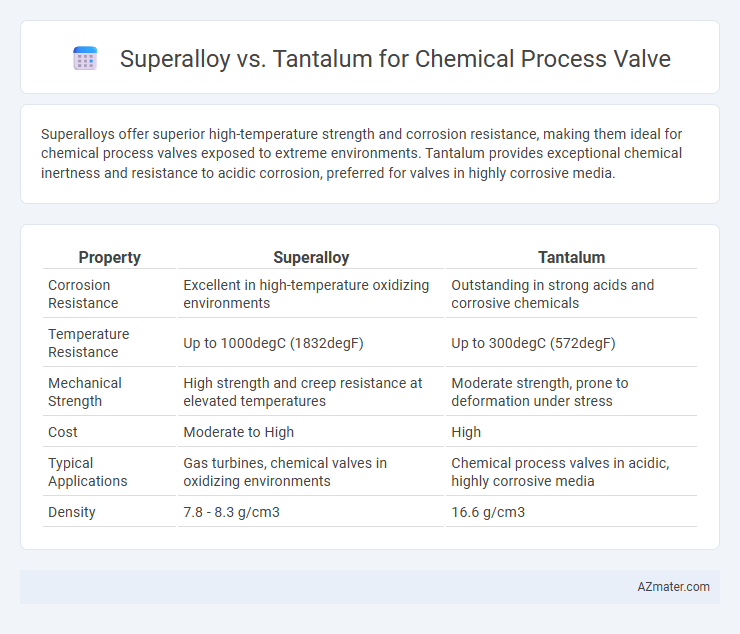Superalloys offer superior high-temperature strength and corrosion resistance, making them ideal for chemical process valves exposed to extreme environments. Tantalum provides exceptional chemical inertness and resistance to acidic corrosion, preferred for valves in highly corrosive media.
Table of Comparison
| Property | Superalloy | Tantalum |
|---|---|---|
| Corrosion Resistance | Excellent in high-temperature oxidizing environments | Outstanding in strong acids and corrosive chemicals |
| Temperature Resistance | Up to 1000degC (1832degF) | Up to 300degC (572degF) |
| Mechanical Strength | High strength and creep resistance at elevated temperatures | Moderate strength, prone to deformation under stress |
| Cost | Moderate to High | High |
| Typical Applications | Gas turbines, chemical valves in oxidizing environments | Chemical process valves in acidic, highly corrosive media |
| Density | 7.8 - 8.3 g/cm3 | 16.6 g/cm3 |
Introduction to Chemical Process Valve Materials
Chemical process valve materials must withstand high temperatures, aggressive corrosive environments, and mechanical stress to ensure durability and reliability. Superalloys offer exceptional strength and oxidation resistance at elevated temperatures, making them ideal for high-performance valve components in chemical processing. Tantalum, known for its outstanding corrosion resistance to strong acids and harsh chemicals, is preferred for valves exposed to highly aggressive media, balancing toughness and chemical inertness.
Overview of Superalloys in Industrial Applications
Superalloys, primarily composed of nickel, cobalt, or iron, exhibit exceptional strength, corrosion resistance, and thermal stability, making them ideal for chemical process valves in harsh industrial environments. Their ability to withstand high temperatures and aggressive chemicals ensures long service life and reliable performance in petrochemical, refinery, and power generation applications. Compared to tantalum, superalloys offer superior mechanical properties and cost efficiency, especially in high-pressure and high-temperature valve operations.
Tantalum: Properties and Industrial Relevance
Tantalum exhibits exceptional corrosion resistance, particularly against acids and aggressive chemical environments, making it highly suitable for chemical process valves. Its high melting point of 3017degC and excellent ductility enable reliable performance under extreme temperature and pressure conditions. Tantalum's industrial relevance is underscored by its widespread use in valve components for hydrochloric acid and other highly corrosive substances where Superalloys may fail due to oxidation or chemical attack.
Corrosion Resistance: Superalloy vs Tantalum
Superalloys exhibit excellent corrosion resistance in high-temperature and oxidative environments, making them suitable for aggressive chemical processes involving acids and oxidizers. Tantalum offers superior resistance to a broader range of corrosive chemicals, including strong acids like hydrochloric and sulfuric acid, due to its stable oxide film that prevents degradation. For chemical process valves, tantalum provides enhanced longevity in highly acidic environments, while superalloys perform better under high-temperature oxidative stress.
Mechanical Strength and Durability Comparison
Superalloys exhibit superior mechanical strength and high-temperature durability compared to tantalum, making them ideal for chemical process valves exposed to extreme conditions and thermal cycling. While tantalum offers excellent corrosion resistance and ductility, its mechanical strength is lower, limiting its use in high-stress valve components. The combination of creep resistance and fatigue strength in superalloys ensures longer valve lifespan and reliability in demanding chemical processing environments.
Temperature Performance in Aggressive Environments
Superalloys exhibit exceptional high-temperature strength and oxidation resistance, maintaining mechanical integrity above 1000degC in aggressive chemical process valve applications. Tantalum offers outstanding corrosion resistance in highly acidic environments but has a lower melting point around 3017degC and limited high-temperature strength compared to superalloys. For chemical process valves operating under extreme thermal conditions, superalloys provide superior temperature performance, while tantalum excels in specific corrosive scenarios at moderate temperatures.
Cost Analysis: Superalloys Versus Tantalum
Superalloys generally offer lower initial costs compared to tantalum when used in chemical process valves due to their widespread availability and established manufacturing processes. Tantalum valves, while significantly more expensive, provide superior corrosion resistance and longer lifespan in highly aggressive chemical environments, potentially reducing total lifecycle costs. Cost analysis must weigh upfront investment against maintenance, replacement frequency, and process downtime associated with material performance under specific chemical conditions.
Fabrication and Machinability Considerations
Superalloys exhibit excellent high-temperature strength and corrosion resistance essential for chemical process valves, but their fabrication is often challenging due to work-hardening tendencies and the need for specialized welding techniques. Tantalum offers superior corrosion resistance, especially against aggressive chemicals, and is easier to machine due to its ductility and thermal conductivity, though it requires careful handling to avoid contamination and galling during fabrication. Selecting between superalloys and tantalum involves balancing fabrication complexity with machinability and chemical performance to optimize valve durability and maintenance.
Typical Applications: Choosing the Right Material
Superalloys excel in chemical process valves used in high-temperature and high-pressure environments, such as petrochemical refining and power generation, due to their exceptional strength and corrosion resistance. Tantalum, renowned for its outstanding resistance to aggressive acids and high corrosion rates, is preferred in valves handling strong chemicals like hydrochloric and sulfuric acids in pharmaceutical and chemical manufacturing. Selecting the right material depends on balancing factors such as operating temperature, corrosive media, mechanical stress, and cost-effectiveness to ensure valve longevity and performance.
Summary: Selecting the Optimal Valve Material
Superalloys offer superior high-temperature strength, corrosion resistance, and oxidation resistance, making them ideal for harsh chemical processing environments where durability and longevity are critical. Tantalum, known for exceptional corrosion resistance to strong acids and chemical inertness, excels in highly corrosive media but lacks the mechanical strength of superalloys at elevated temperatures. Selecting the optimal valve material depends on balancing corrosion resistance, temperature requirements, mechanical strength, and cost-effectiveness for specific chemical process conditions.

Infographic: Superalloy vs Tantalum for Chemical Process Valve
 azmater.com
azmater.com